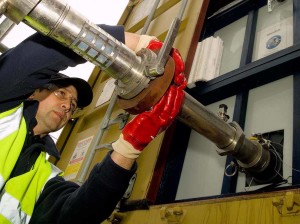From Barrel to Bulk
Have you ever looked at those massive freight containers stacked row-upon-row in any given port in the world and wondered which of them contained wine by the 26,000 litre container?
Probably not, as we’re more used to thinking in terms of bottles, boxes and pallets more in keeping with the geometric serried rows of fine wooden barrels aboard those romantic wind-blown schooners that traditionally used ply wine from one country to another two centuries ago.
But you should consider this prospect, for only two years ago shipments of wine in bulk – in large tanker-sized 26,000 litre containers and 24,000 litre flexi-tanks – had nearly tripled compared to what was being exported around the world 10 years before that in 2003.
This bulk wine transportation is mostly confined to New World wines.
Growth in bulk wine shipping
Where bulk wine accounted for 28% of total wine exports from the New World back then, this had risen to 39% by 2007 and to 50% of global New World wine exports by 2013. Over the course of a decade bulk wine exports rose from 471 million litres to 1.47 billion litres.
Naturally, with bulk format becoming half of total export volumes, this was at the expense of shipments of wine in bottle, particularly among New World suppliers.
So it’s not hard to tell if that bottle of wine in your hand has been bulk transported. It will be indicated somewhere on the label as having been bottled in the UK.
According to a report entitled The Incredible Bulk: the Rise in Global Bulk Wine Trade from Rabobank’s global Food & Agribusiness Research and Advisory department, cost savings provide the overriding driver of shipping wine in bulk, stripping $140 million in transport, duty, packaging and associated costs from supply chains of New World producers. The shift in trade to bulk shipments equates to well over $1 billion generated in destination markets versus production source, state the report’s authors Stephen Rannekleiv and Marc Soccio.
“Until the past decade, wine shipments were generally done in stainless steel tanks on trucks which was more costly,” stated Stephen Rannekleiv.
But advances in transportation technology, in the containers themselves and in shipping techniques have changed a good deal particularly in the last decade.
UK ports regularly land these vinous containers in the from of ISO tanks, Flexi-tanks (giant bag-in-the-boxes assembled and filled inside a standard 20 foot shipping container) or in food-grade road tankers.
Back in 2011, Rabobank forecast that bulk wine shipments will grow further despite tightened global supply as suppliers continue to seek low cost supply chain and distribution solutions.
However by December last year this prediction had been modified somewhat.
In its World Wine Map 2014 Rabobank stated that there would be a slowing of both the growth rate of bulk wine shipments and production growth of New World suppliers.
This prediction proved accurate. Stephen Rannekleiv confirmed to Drinks Industry Ireland that, “In 2014, the share of New World wine that was shipped in bulk actually lost some share. It might make a slight comeback in 2015, given the growth in Chilean shipments, but it seems that bulk share of overall shipments is levelling off with some minor fluctuations from year to year”.
Bulk wine lost four percentage points to fall back to 46% of total New World wine shipments last year.
“The advent of improved technology for shipping bulk wine has provided great efficiencies for shipping certain types of wine, but it is not an appropriate solution in all cases,” according to the World Wine Map report.
It points out, for example, that bulk shipping is not suitable for brands that have small volumes in a given market.
“The cost of setting up alternative systems for managing the process of bottling in a foreign country will outweigh any cost savings from shipping in bulk,” it warns.
That being so, it should come as no surprise to find that a lot of bulk wine destined for Irish shelves comes in via France, Germany, the UK and Denmark – wherever there’s a bottling facility within reach of the UK and Ireland, really.
But Rabobank also identifies higher-value wine brand owners as being “seemingly anxious” about the risk to their brand perceptions which they believe could suffer as a result of bulk shipping.
Bulk shipping, says Rabobank in its World Wine Map 2014, has had “a profound effect on wineries’ ability to build brands”.
It has allowed large wine companies, retail chains and negociants to effectively use foreign-source wine to build brands in their local markets.
So what happens to the bulk wine once it’s landed ashore?
In the UK, a number of companies have set about the task of bottling bulk wine landed at docks such as Teeside, Newcastle, Southhampton or Portsmouth.
These include some of the big names in UK bulk wine processing: Kingsland, Broadlands, Quinn Group, PLB/Vivendum and the Lanchester Group.
Such companies import wine in bulk and bottle it or otherwise package it for the retailer or brand owner. In some there’s enough bulk wine being bottled to feed the production line 24/7. These companies provide a dedicated service capability to the UK and Irish wine trades.
Michael O’Brien is Business Manager for Ireland with one such company, the Lanchester Group subsidiary Lanchester Wine Cellar.
At Lanchester Group’s Greenmount Bottling Plant in Durham, bulk wine is taken in and bottled for a customer base that includes major retailers (multiples, pub chains and convenience stores), national and regional wholesalers as well as brand owners accessing all trade sectors.
Naturally warehousing plays a significant part in the logistics of bottling bulk wines.
The Greenmount Bottling company has invested more than £10 million in the infrastrucure, efficiencies, ‘greenness’ and development of the business over an 18 month period and the Lanchester Group has become one of only two North East England-based companies to make it into the Investec Mid Market Top 100.
It also produces own-label for retailers as well as exclusive labels and it exports bottled format wine from bulk to the EU, the US and Asia.
“To give some idea of the scale of production and processing going on in bulk wine processing” explains Michael O’Brien, “Lanchester’s bottling facility can handle two 15,000 bottle (75cl) per hour lines, one 14,500 bottle (75cl) per hour line, two 12,000 bottle (75cl, 250ml, 187ml) per hour lines, a Tetra Pak line which can handle 7,500 units (75cl/1L) per hour, a ‘Bag In Box’ line which can handle 32 units a minute and a semi-automatic 1.5L Pouch Filler. The Tetra Pack and BIB Fillers mainly serve the Scandinavian wine market.”
And business is growing. Last year the company filled 67 million litres of product. The projected fill this year will top 100 million litres – and even then it would only be working at half its total capacity.
In this particular company, production is currently 24 hours a day seven days a week.
Companies such as this get their bulk wine supplies from all over the world: Argentina, Chile, the US, France, Germany, South Africa, Australia and New Zealand to name just a few.
In Lanchester’s case, the company prides itself on a two-week turnaround between the bulk product arriving at the dockside, getting it processed and packaged and delivering it to the customer.
As for the future, Stephen Rannekliev told Drinks Industry Ireland, “To date, the growth of bulk wine shipments has centered around shipping lower-valued, more commoditised wines. If bulk wine shipments are to continue gaining share, it will have to expand into higher-value products. The ability to expand into these price segments will be limited by restrictions of many DOCs on bottling outside the appellation”.
But perhaps Lanchester and other such packaging companies should also bear in mind the closing comments from Rabobank’s World Wine Map 2014 which states, “Shipping wine in bulk will remain an important and integral part of the wine industry, but its growth rate will slow as the most important efficiencies from making this switch have already been achieved”.
The latest 2014 figures – 1.3 billion litres down from 12.4 billion in 2013 – suggest this to be true.









